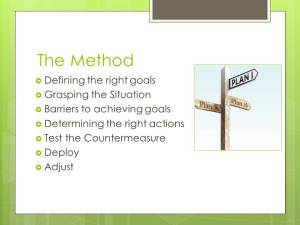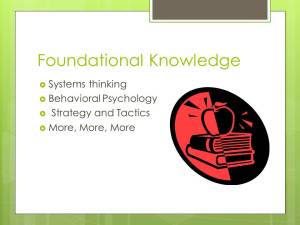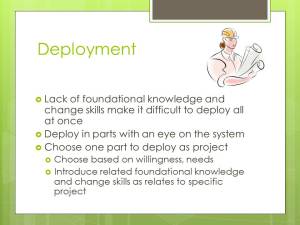 How about some building blocks to starting a change effort out on the right footing.
How about some building blocks to starting a change effort out on the right footing.
Priority and Time
If you want a successful change effort, it has to be a priority. It doesn’t have to be THE priority but it will have to replace an existing priority. Something has to give. You can’t just pile it on. It won’t get worked on. This applies to both you and your people. Everybody’s priorities will have to change.
Not only does it have to be a priority for your people, it has to be a priority for you. If you’re not making it a priority, it’s not a priority. People will work on the things they know are a priority for you. And no amount of cheap talk will steer them away from knowing what your real priorities are.
Your desire to make this happen it isn’t enough either. Your understanding of the need isn’t enough. It requires that you make it a priority and making it a priority requires time. Time is the most precious and most powerful tool you have. If you don’t spend real time on it, it’s not a priority.
You can’t hide it. Trust me. Everyone will know if you are devoting time. And if you are devoting time, your people will devote time. Simple equation.
And you can’t hand it off. Not to anyone. Not to your right hand, not to a project manager, not to a change agent.
Clarity of Purpose
No reason to move ahead if you don’t have this. What are you trying to change? What are you trying to achieve? These have to be real tangible things. They can’t be things like, we want to be more nimble. Sure, we all want to be more nimble. But I might be thinking I’m nimble and you might be thinking I’m a clod. Doesn’t work. Everyone has to be able to understand where you are going.
You have to get to the heart of what you are trying to achieve. Or you at least have to be close and be willing to be flexible as you dive into the process.
There are many different ways to get to the heart of the matter. However you get there, slow down to speed up. Get this right.
Focus and Discipline
Fires will start up for whatever reason. We all know they will. They’ll be very distracting. Do not give in to firefighting mode. Stay focused. You have to keep the change a priority.
But the fire will come and they often have to be put out. Send someone to deal with it. Not you. Not anyone who will have to de-prioritize the change project.
Why? Because it sends the wrong message. It sends the message that firefighting is more important than the change project. It is not. Firefighting is reactive. Change projects are proactive.
You say you have to send project members to fight fires because you don’t have enough resources? Well, you better plan for that. You know it’s going to happen. Designate someone to deal with that now. If you don’t have that person, you need to start looking now.
Education and Engagement
Everyone needs to understand the purpose of the change; they also need to understand their role.
That takes active engagement. This can’t be a top down activity. This can’t happen by directive.
This takes active education—of everyone impacted. Whether that education is on the change itself or the act of changing. That has to start right now. Not right before the change is rolled out.
It takes dialog. Lots of dialog. You have to keep discussing it because it will evolve. It will not be in the end what it was in the beginning.
Time
Yes, back to time. All of these take time. Lots of time.
Start
If you can accept that this is what it will take, then you can start. Now you can walk into the fire with Eyes Wide Open.
 “I don’t know” can be hard words to utter when you are trying to lead or guide people. I’ve always said you have to become comfortable with the unknown in order to take people somewhere new.
“I don’t know” can be hard words to utter when you are trying to lead or guide people. I’ve always said you have to become comfortable with the unknown in order to take people somewhere new.





















